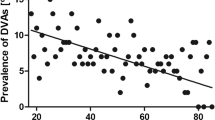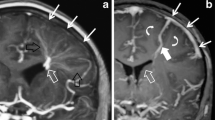Abstract
Purpose
This study evaluated morphological features of developmental venous anomalies (DVAs) based on magnetic resonance imaging (MRI) findings. The study also evaluated the factors affecting the visibility of DVAs on MRI.
Methods
We reviewed contrast-enhanced MRIs of 75 patients with DVA. The images were selected from 1,165 consecutive cranial MRIs. The images were examined for the DVA location, the number of collecting veins, the collecting vein diameter, drainage veins and sinuses, any accompanying parenchymal abnormalities or lesions, and the DVA visibility on MRI.
Results
DVAs prevalence was determined as 6.4 %. A total of 88 DVAs were observed. Single DVAs were observed in 65 patients, two were observed in 7 patients and three were observed in 3 patients. The DVA caputs had deep localization most frequently in 54.5 % of patients. A total of 98 collecting veins were identified, with a single vein identified in 80 DVAs. A statistically significant difference (p = 0.000) was found in the diameter of the collecting veins between DVAs that were the visible and nonvisible on noncontrast MRI.
Conclusions
Most frequently, a single DVA was observed in the patients. A DVA caput could be located in the deep, subcortical, juxtacortical or deep + subcortical and juxtacortical + subcortical regions. Increasing collecting vein diameter increased visibility on noncontrast MRI, and small DVAs could be overlooked, even with contrast-enhanced MRI series if the images were not examined carefully.





Similar content being viewed by others
References
Ruiz DS, Yιlmaz H, Gailloud P. Cerebral developmental venous anomalies: current concepts. Ann Neurol. 2009;66:271–83.
Ruiz DS, Gailloud P. Cerebral developmental venous anomalies. Child Nerv Syst. 2010;26:1395–406.
Sarwar M, McCormick WF. Intracerebral venous anjioma. Case report and review. Arch Neurol. 1978;35:323–5.
Lasjaunias P, Burrows P, Planet C. Developmental venous anomalies (DVA): the so-called venous anjioma. Neurosurg Rev. 1986;9:233–42.
Lee M, Kim MS. Image findings in brain developmental venous anomalies. J Cerebrovasc Endovasc Neurosurg. 2012;14:37–43.
Saito Y, Kobayashi N. Cerebral venous angiomas: clinical evaluation and possible etiology. Radiology. 1981;139:87–94.
Lee C, Pennington MA, Kenney CM 3rd. MR evaluation of developmental venous anomalies: medullary venous anatomy of venous angiomas. AJNR Am J Neuroradiol. 1996;17:61–70.
Huang YP, Patel SC, Robbins A, Chaudhary M. Cerebral venous malformation and a new classification of cerebral vascular malformations. In: Kapp JP, Schmidek HH, editors. The cerebral venous system and its disorders. Orlando:Grune & Stratton; 1984. pp 373–474.
Garner TB, Curling OD, Kelly DL, Laster DW. The natural history of intracranial venous angiomas. J Neurosurg. 1991;75:715–22.
Wilms G, Demaerel P, Marchal G, Baert AL, Plets C. Gadolinium enhanced MR imaging of cerebral venous angiomas with emphasis on their drainage. J Comput Assist Tomogr. 1991;15:199–206.
Valavanis A, Wellauer J, Yasargil MG. The radiological diagnosis of cerebral venous angioma: cerebral angiography and computed tomography. Neuroradiology. 1983;24:193–99.
Ostertun B, Solymosi L. Magnetic resonance angiography of cerebral developmental venous anomalies: its role in differential diagnosis. Neuroradiology. 1993;35:97–104.
Ruiz DS, Delavelle J, Yιlmaz H, Gailloud P, Piovan E, Bertramello A, et al. Parenchymal abnormalities associated with developmental venous anomalies. Neuroradiology. 2007;49:987–95.
Uchino A, Hasuo K, Matsumoto S, Masuda K. Double cerebral venous angiomas: MRI. Neuroradiology. 1995;37:25–8.
Huber G, Henkes H, Hermes M, Felber S, Terstegge K, Piepgras U. Regional association of developmental venous anomalies with angiographically occult vascular malformations. Eur Radiol. 1995;6:30–7.
Santucci GM, Leach JL, Ying J, Leach SD, Tomsick TA. Brain parenchymal signal abnormalities associated with developmental venous anomalies: detailed MR imaging assessment. AJNR Am J Neuroradiol. 2008;29:1317–23.
Abe T, Singer RJ, Marks MP, Norbash AM, Crowley RS, Steinberg GK. Coexistence of occult vascular malformations and developmental venous anomalies in the central nervous system: MR evaluation. AJNR Am J Neuroradiol. 1998;19:51–7.
Tsui YK, Tsai FY, Hasso AN, Greensite F, Nguyen BV. Susceptibility-weighted imaging for differential diagnosis of cerebral vascular pathology: a pictorial review. J Neurol Sci. 2009;287:7–16.
de Souza JM, Domingues RC, Cruz LC Jr., Domingues FS, Iasbeck T, Gasparetto EL. Susceptibility-weighted imaging for the evaluation of patients with familial cerebral cavernous malformations: a comparison with T2-weighted fast spin-echo and gradient-echo sequences. AJNR Am J Neuroradiol. 2008;29:154–8.
Dammann P, Barth M, Zhu Y, Maderwald S, Schlamann M, Ladd ME, et al. Susceptibility-weighted magnetic resonance imaging of cerebral cavernous malformations: prospects, drawbacks, and first experience at ultra-high field strength (7-Tesla) magnetic resonance imaging. Neurosurg Focus. 2010;29(3):E5.
Oran I, Kiroglu Y, Yurt A, Ozer FD, Acar F, Dalbasti T, et al. Developmental venous anomaly (DVA) with arterial component: a rare cause of intracranial hemorrhage. Neuroradiology. 2009;51:25–32.
Hanson EH, Roach CJ, Ringdahl EN, Wynn BL, DeChancie SM, Mann ND, et al. Developmental venous anomalies: appearance on whole-brain CT digital subtraction angiography and CT perfusion. Neuroradiology. 2011;53:331–41.
Dorn F, Brinker G, Blau T, Kabbasch C, Reiner M, Liebig T. Spontaneous thrombosis of a DVA with subsequent intracranial hemorrhage. Clin Neuroradiol. 2012; doi:10.1007/s00062-012-0190-x
Burke L, Berenberg RA, Kim KS. Choreoballismus: a nonhemorrhagic complication of venous angiomas. Surg Neurol. 1984;21:245–8.
Yagmurlu B, Fitoz S, Atasoy C, Erden I, Deda G, Unal O. An unusual cause of hydrocephalus: aqueductal developmental venous anomaly. Eur Radiol. 2005;15:1159–62.
Berbel-Garcia A, Martinez-Salio A, Porta-Etessam J, Saiz-Diaz R, Gonzalez-León P, Ramos A, et al. Venous angioma associated with atypical ophthalmoplegic migraine. Headache. 2004;44:440–2.
Malinvaud D, Lecanu JB, Halimi P, Avan P, Bonfils P. Tinnitus and cerebellar developmental venous anomaly. Arch Otolaryngol Head Neck Surg. 2006;132:550–3.
Ferreira D, Mendes V, Vide A, Costa JD. Developmental venous anomaly of the internal auditory canal in a child with unilateral sensorineural hearing loss—a rare association. Pediatr Radiol. 2012;42:1021–3.
Peterson AM, Williams RL, Fukui MB, Meltzer CC. Venous angioma adjacent to the root entry zone of the trigeminal nerve: implications for management of trigeminal neuralgia. Neuroradiology. 2002;44:342–6.
Conflict of Interest
We declare that we have no conflict of interest.
Author information
Authors and Affiliations
Corresponding author
Rights and permissions
About this article
Cite this article
Gökçe, E., Acu, B., Beyhan, M. et al. Magnetic Resonance Imaging Findings of Developmental Venous Anomalies. Clin Neuroradiol 24, 135–143 (2014). https://doi.org/10.1007/s00062-013-0235-9
Received:
Accepted:
Published:
Issue Date:
DOI: https://doi.org/10.1007/s00062-013-0235-9




